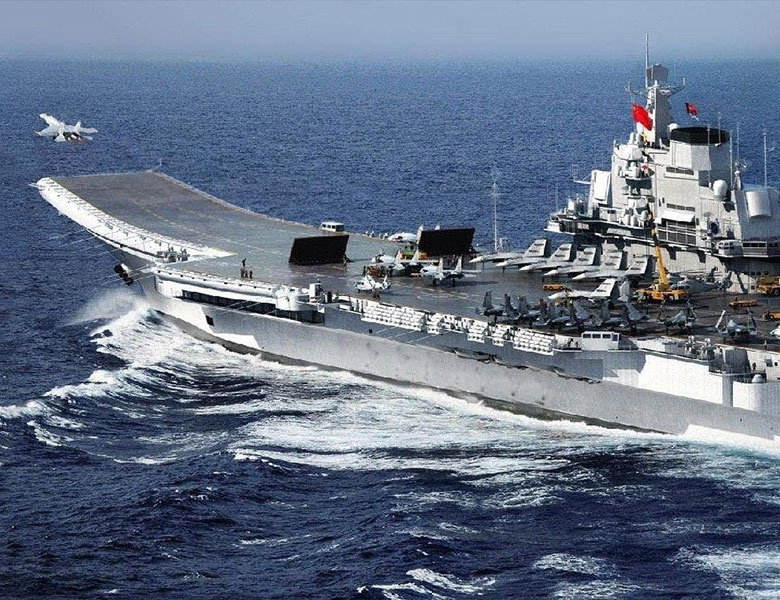What’s happening
The long-awaited official announcement has finally been made.
The first confirmations came in Chinese: “China’s aircraft carrier platform is undergoing sea trials today (中国航母平台今日进行出海航行试验). Xinhua News: China’s aircraft carrier platform is undergoing sea trials on August 10 (新华网快讯: 我航母平台8月10日进行出海航行试验).”
Xinhua’s English-language news service subsequently reported: “China’s refitted aircraft carrier left its shipyard at Dalian Port in northeast Liaoning Province on Wednesday morning to start its first sea trial. Military sources said that the first sea trial was in line with schedual [sic] of the carrier’s refitting project and would not take a long time. After returning from the sea trial, the aircraft carrier will continue refit and test work.”
China’s Navy has finally realized its longtime dream of obtaining an aircraft carrier and putting it to sea. It has been a long road from the Guomindang’s 1929 rejection of naval commander Chen Shaokuan’s proposal for building a Chinese aircraft carrier to the acquisition and refitting of the former Ukrainian carrier Varyag in Dalian Naval Shipyard, a task essentially as complex as building a carrier from scratch. Now, 82 years after Admiral Chen’s proposal, China has launched its first carrier for a set of sea trials that Hong Kong media sources estimate will last for 15 days (香港商報訊 [Hong Kong Commercial Daily]).
Having avoided the winds and waves recently sent to the Yellow Sea by Typhoon Muifa, the carrier will subject China to even more diplomatic turbulence as its neighbors react to the reality that their giant neighbor now has a basically-functioning carrier.
What it means
A newly-wed couple wants a ‘starter home,’ a new great power wants a ‘starter carrier.’ China’s ‘starter carrier’ is of very limited military utility, and will primarily serve to confer prestige on a rising great power, to help the military master basic procedures, and to project a bit of power.
The carrier’s maiden voyage appears to be a show cruise conducted close to home to both make the vessel a bit less accessible to prying eyes (and unauthorized digital cameras) and also keep it near its home port if any mechanical problems materialize. Key questions that may arise in the course of this voyage include:
(1) How reliable is the vessel’s propulsion system? The ship’s powerplant and drivetrain are among the highest probability risk factors that could complicate the maiden cruise.
(2) Will China more aggressively intercept reconnaissance flights and/or declare a maritime and aerial exclusion zone in the ship’s vicinity? The carrier’s first excursion from port offers an excellent opportunity for air and seaborne reconnaissance assets from the U.S., Japan, and other regional armed forces to gather photographic, acoustic, and perhaps signals intelligence on the new Chinese carrier.
(3) Will PLAN Aviation attempt to land aircraft on the ship at sea? Other possibilities include helicopter operations and touch and go runs, which could be facilitated by the growing base of PLAN helicopter pilots with shipborne operating experience, courtesy of the Gulf of Aden anti-piracy mission.
Aircraft operations are of course the fundamental reason for having a carrier capability, and we would be surprised if the maiden cruise includes actual landings of fixed wing aircraft (takeoffs represent a lower hurdle, thought the aircraft would somehow have to reach the deck in the first place). When operating aircraft from carriers, accidents are highly likely as carrier aviation is a risky and costly business.
Prof. Robert Rubel (CAPT, Ret.), a former U.S. Naval Aviator who is now Dean of the Center for Naval Warfare Studies at the U.S. Naval War College, notes that between 1949, when jets started being deployed in large numbers by the U.S. Navy, until 1988, when the combined U.S. Navy/USMC accident rate was lowered to USAF levels, the naval services lost almost 12,000 aircraft and 8,500 aircrew.[i] In 1954 alone, the Navy and Marines lost 776 aircraft and 535 crewmen and carrier-based tactical aviation suffered higher proportionate losses than the naval services as a whole.[ii]
To be sure, China has resolved some of the most fundamental physical issues involved in launching and landing aircraft from a small moving airfield, but the process remains immensely difficult and even a less-aggressive carrier operator than the U.S. is almost certain to suffer substantial unexpected losses of aircraft and crew as it works to build its operational knowledge and human capital. It remains uncertain what financial and political costs Chinese carrier aircraft losses will incur, but clearly the first Chinese carrier aviators and ship captains face steep challenges ahead.
Still, after waiting over eight decades for a carrier of its own, China can afford to be patient and methodical in mastering its operation.
Additional reading on China’s carrier program:
For an assessment of the larger implications of China’s deck aviation development, see Abraham M. Denmark, Andrew S. Erickson, and Gabriel Collins, “Should We Be Afraid of China’s New Aircraft Carrier? Not yet.,” Foreign Policy, 27 June 2011.
For operational aspects of China’s first carrier-capable aircraft, see Gabe Collins and Andrew Erickson, “Flying Shark” Gaining Altitude: How might new J-15 strike fighter improve China’s maritime air warfare ability?,” China SignPost™ (洞察中国), No. 38 (7 June 2011).
For drivers and constraints concerning Chinese deck aviation, see Gabe Collins and Andrew Erickson, “The ‘Flying Shark’ Prepares to Roam the Seas: Strategic pros and cons of China’s aircraft carrier program,” China SignPost™ (洞察中国), No. 35 (18 May 2011).
For relevant defense industrial factors, see Gabe Collins and Andrew Erickson, “LNG Carriers to Aircraft Carriers? Assessing the potential for crossover between civilian and military shipbuilding in China,” China SignPost™ (洞察中国), No. 12 (18 December 2010).
For an early assessment of Chinese aircraft carrier options, see Andrew S. Erickson and Andrew R. Wilson, “China’s Aircraft Carrier Dilemma,” Naval War College Review, 59. 4 (Autumn 2006): 13-45.
[i] Robert Rubel, “The U.S. Navy’s Transition to Jets,” Naval War College Review 63.2 (Spring 2010): 51, http://www.usnwc.edu/getattachment/76679e75-3a49-4bf5-854a-b0696e575e0a/The-U-S–Navy-s-Transition-to-Jets.
[ii] Ibid., 52.


